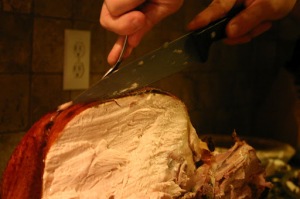


Now, everyone has their own way of making “the perfect” turkey. Brined, wrapped in cheesecloth, broken down, deep-fried, basted religiously…the list goes on. All steps are taken to get a juicy, moist, yet fully cooked bird. As a family we have tried it a few ways in the past, sometimes producing dry meat, but have settled on a very traditional method, that we will keep perfecting as the years go by. This year the meat was moist, the skin lovely and browned, and it didn’t take forever, so I’d say that’s pretty good! Though I was nervous about manning the turkey by myself, and a few minor freak outs did occur as I wavered the temperature up and down, it forgave me in the end and reminded me that following some rules is never a bad idea. I baste it regularly, admit to a pretty generous addition of butter, and leave it unstuffed. This is more of a method than a recipe, and I don’t provide a time. This is because every turkey is different, and I’ve never punched in a time that ends up being correct. If you do need a timer to remind you where you are, set it for a minimum amount, about two hours, and keep checking the temperature near the hip joint so you have an idea of where you are heading. When it gets close, you are going to want to bring the temperature up a bit to brown that skin, and you won’t know that you’re close if you don’t regularly check the temperature.
1) Take the turkey out an hour before you plan on cooking it to help get it to room temperature. While it’s hanging out (far from where the dog/cat/small children can reach it), you can prepare your veggies. We use:
– 4 carrots, chopped roughly
– 4 celery sticks, chopped roughly
– 4 onions, quartered
– 2 parsnips, chopped roughly
– 2 fennel bulbs, quartered
2) Arrange veggies in the bottom of your roasting pan, putting aside 2 onions worth of quarters to put in the turkey. As for the turkey, get out
– 1 c butter
– handful of fresh sage leaves
– handful of fresh thyme
– handful of fresh rosemary
Mash herbs in with half a cup of the butter. Put a small slit, just large enough for your hand to squeeze in, in the skin near the back opening of the turkey. Rub the herb butter inside the skin, pressing it all over the top into the front of the turkey. This will help keep the breast moist. Rub the other half-cup all over the skin, which will really help bring out a nice colour in it. Season the cavity with 1 Tbsp salt and place the rest of the onions inside. Tie the legs together firmly with a string. Cover the wingtips with tin foil, and loosely cover the legs with tin foil.
3) Heat the oven up to 325 degrees F. In the bottom of your roasting pan, pour in 4 cups of water and 2 cups of wine to help keep some moisture in the oven. Put turkey in the oven (finally!) with the lid off. Baste every hour after the first hour and a half. If the skin doesn’t seem to be browning, add a little extra butter when you baste.
4) When the leg meat near the hip joint reads 160 degrees F, its time to turn the heat up. 400 degrees F for about another 20-30 minutes, until the turkey temperature reads 170 degrees F in the same spot.
5) Remove the turkey! Place on a cutting board/platter to set for 20-30 minutes to let all those juices settle.









